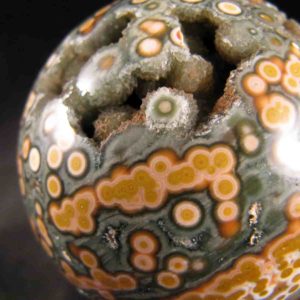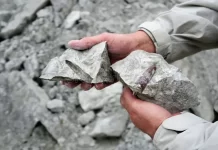
What is Agate?
Agate is a rock consisting primarily of cryptocrystalline silica, chiefly chalcedony, alternating with microgranular quartz. It is characterized by its fineness of grain and variety of color. Although agates may be found in various kinds of host rock, they are classically associated with volcanic rocks and can be common in certain metamorphic rocks.
What is Jasper?
Jasper, an aggregate of microgranular quartz and/or chalcedony and other mineral phases, is an opaque, impure variety of silica, usually red, yellow, brown or green in color; and rarely blue. The common red color is due to iron(III) inclusions. The mineral aggregate breaks with a smooth surface and is used for ornamentation or as a gemstone. It can be highly polished and is used for items such as vases, seals, and snuff boxes. The specific gravity of jasper is typically 2.5 to 2.9. A green variety with red spots, known as heliotrope (bloodstone), is one of the traditional birthstones for March. Jaspilite is a banded iron formation rock that often has distinctive bands of jasper.
What is Chalcedony?
Chalcedony is a cryptocrystalline form of silica, composed of very fine intergrowths of quartz and moganite. These are both silica minerals, but they differ in that quartz has a trigonal crystal structure, while moganite is monoclinic. Chalcedony’s standard chemical structure (based on the chemical structure of quartz) is SiO2 (silicon dioxide).
Chalcedony has a waxy luster, and may be semitransparent or translucent. It can assume a wide range of colors, but those most commonly seen are white to gray, grayish-blue or a shade of brown ranging from pale to nearly black. The color of chalcedony sold commercially is often enhanced by dyeing or heating.
The name chalcedony comes from the Latin chalcedonius (alternatively spelled calchedonius). The name appears in Pliny the Elder’s Naturalis Historia as a term for a translucid kind of Jaspis. The name is probably derived from the town Chalcedon in Asia Minor. The Greek word khalkedon (χαλκηδών) also appears in the Book of Revelation (Apc 21,19). It is a hapax legomenon found nowhere else, so it is hard to tell whether the precious gem mentioned in the Bible is the same mineral known by this name today.
How to tell the difference between Jasper and an Agate?
If you put light behind the material and you can see through it, then it is an Agate if you can’t then your holding Jasper.
The more complex answer is that it is not always that straightforward. The simple science behind this question is that both Agates and Jaspers are comprised of Quartz- which is one of the most common minerals on the planet. Quartz is comprised of two major types- macrocrystalline (large crystal) and cryptocrystalline (small crystal).
Related Articles:
Lake Superior Agate
Landscape Agate
Amazing Agate Photos
Why Minerals Are Colored?
How Do Minerals & Rocks Get Their Names?










